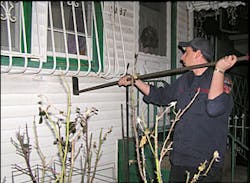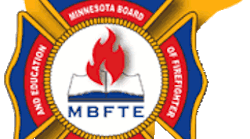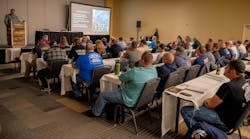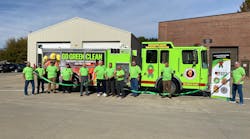The installation of security devices throughout the country has been on the increase for many years, and no matter where you live, it should be a concern for any firefighter that is going to be engaged during an interior attack.
"Mayday, Mayday, Mayday, we are trapped in a room and the fire is cutting off our egress. We are stuck behind window bars!! This is a call for help no one wants to hear on the fireground, but if it should happen, are you capable of handling it? Let's go through the basics of window bars, window gates and barred storm doors.
The installation of security devices throughout the country has been on the increase for many years, and no matter where you live, it should be a concern for any firefighter that is going to be engaged during an interior attack. Security devices can be found in any type of occupancy whether it is a single family occupancy or a multiple dwelling and can consist of window bars, window gates or security bar storm doors. The location of window bars can be on the inside or outside of the windows and it is not uncommon to find them on all four sides of a building and on all floors too. In most cases, not all, you will find window bars on private dwellings or converted dwellings and window gates on multiple dwellings that have fire escapes.
Laws & Regulations for Bars and Gates
Any area that has experienced fire related deaths due to the installation of one of these security devices will more often than not promulgate a law stating where these devices can be installed as well as where they can not be installed. For example, in New York City the Multiple Dwelling Law states, "Iron bars, grilles, gates or other obstructing devices on any window giving access to fire escapes or to a required secondary means of egress shall be unlawful unless such devices are of the type approved by the Board of Standards and Appeals and are installed and maintained as prescribed by the Board". In addition, the Department of Consumer Affairs states, "If a window gate, grille, bars or similar device has not been approved by the "Board" for use on fire escape windows, the seller must place a label or tag on it stating that:
- It is illegal to use the device on a fire escape window;
- Use of the device on a fire escape window is a serious safety hazard;
- Use of the device on a fire escape window may subject the user to a fine.
Construction Variations
Security bar storm doors found on entrance ways will usually have double key lock assemblies and tempered glass or Lexan. Construction of the bars on both the doors and windows will vary from a light metal to heavy wrought iron and steel. The manner in which they are attached to the structure will vary and is going to have a direct impact on how easily we can get through these devices. They can be attached by being bolted or screwed into the wood frame of the window or door, or they can be set in to mortar, brick, or concrete.
The potential danger of these devices in a fire situation is clearly evident. A civilian that may have installed window bars that would permit escape and then places a keyed pad lock on the moving part of the device is not going to get that security device open to allow egress for the occupants (see photo 1). Notice that a large section of the window bars will open on the hinges to the right in the photo. Having civilians trapped behind window bars is a stressful situation, you want some added stress, how about we go back to the first sentence; "Mayday, Mayday, Mayday, we are trapped in a room and the fire is cutting off our egress and we are stuck behind window bars!"
Encountering Devices at a Fire
Upon arrival at a working fire in a dwelling with window bars, it should be transmitted on the radio with a brief description of the type of building so all incoming units are aware of the presence of these devices. The engine company must initiate an aggressive interior attack to control the fire and protect the interior stairs and means of egress for the occupants. A second line should be stretched to back up the first line and if not needed there will deploy to the floor above the fire. This is a precarious position and must be made with good judgment and determination. Ladder companies will have their hands full with their regular assignments and will now need to deploy an additional team to start removing the window bars. It would benefit the incident commander to call additional ladder companies immediately upon recognition of this hazard. If tower ladders are available, use them. They will make a safe platform for working to remove this hazard on the upper floors.
It is essential that we strategically remove the devices to assist in emergency egress or evacuation of our members. If fire is blowing out of a window that has bars on it, it is not necessary to remove those bars. There is no one alive in that room and our efforts will be better placed by removing the bars in the room next to that. We should remove at least one set of bars on each floor to start and continue to remove the window bars on the fire floor and floor above according to the location of the fire and our operating personnel and potential life hazards. The location of the windows that have had the bars removed should be communicated to all units.
If firefighters become trapped behind window bars and their means of egress is cut off, one of the ways to buy them time is to stretch a handline to their location and pass it through the bars to them. They will be able to use this for protection while we are working to create an opening for them. If trapped occupants are discovered, you should transmit their exact location so both interior and exterior operations can be concentrated in that direction.
Removal of Devices
As mentioned before, window bars are attached in a couple of ways. They are: fastened on the exterior face with bolts or screws (see photos 2 through 4); and fastened on the frame of the window with bolts, screws or recessed in to the brick, mortar or concrete (see photos 5 through 7)
An alternative to window bars are window gates. These gates can be the type that swing inward, outward, or are scissor gates. The scissor gate in photo 8 is attached to the outside of the frame. The swinging gate in photo 9 is attached to the inside of the frame. Either way, these gates present a problem when they are locked, and they usually are, and the occupants or firefighters are trying to get out. In photo 10, the gate slides to one side. This one happens to cover two windows, if it covered one window only, it would cut down the size of the opening for egress.
To remove window bars a re-bar cutter may be used but it is a slow process and you may not have the time to spare. Using a saw with an aluminum oxide blade will make fairly quick work of these bars also, but as you ascend you will need a work platform. This is where the tower ladder comes in handy. It is important to properly size up the window bars so you can make the minimum amount of cuts giving you the maximum results. You can also use portable ladders but assure that you have adequate manpower to make this a safe operation. Also, when removing window bars from the second story, make sure the work area below is kept clear so we do not incur any injuries.
Homemade Tool Entry Tools
One tool that I have seen used by FDNY Ladder 126 is homemade for window bar forcible entry. In photos 11 through 15, you can see that it is a rough sawn homemade gadget, but it works terrific. I was working in Queens one day tour and noticed at a job that these firefighters were making quick work of the window bars. When I asked them to show me the tool they were using I was amazed that the whole job did not have this.
It uses leverage and the fulcrum principal to pry these bars right off of their attachment. Even when using this tool on a window bar that is attached in brick or mortar, using the weight of the tool to smash the contact area and chip it up, then prying on the bars, it works extremely well. In photo 11 you can see the "adz" end of the tool being applied to the bottom of the window bars. A few shots on the tool with an axe will seat it properly and the downward pressure should overcome the lag bolts. The two tools compliment each other because they can be used interchangeably when the other fails to do the job.
On one tool (photo 14) you can see how the "U" channel grabs the bar so you can apply the needed upward pressure to remove them. The length of these tools is about six feet and they are made out of one-inch re-bar. In photos 13 and 15 you can see the second tool is set up like a large Halligan without the hook. The "adz" end can be used to bend and pry out a stationary window gate that is attached in to the brick and mortar while the fork end can be used to pry and apply leverage.
Storm Doors Constructed with Steel Bars
As stated earlier, these doors are constructed of steel and Lexan glass. They can be difficult to get through if you have not planned ahead for this type of encounter.
In photo 16 the steel door here was installed after they built a wood frame to fit the door into. It just may be easier to attack the wooden frame than to force entry through the door. In photo 17 the steel door here has a protective cover over the latch. Conventional forcible entry will still work on this door. It may take a little more sweat, but you can get through this.
And in photo 18 this steel door to the basement entrance will make entry more difficult because of the limited space you have to work in. If you're thinking you can just reach through the bars and turn the handle, give it a try, but chances are the double side key lock in engaged. Besides conventional forcible entry, don't forget the rotary saw with the aluminum oxide abrasive disc. It is still a viable option, especially in photo 19. Look how this door is attached. On the hinged side there are two metal bars recessed in to the concrete wall. Perhaps if we cut them we will be able to pry the whole door out of the way.
Steel Enclosures
In some cases you may find what seems to be a steel fortress. They are no more difficult to get in to than any other building; we just have to use our ingenuity. Photos 20 and 21 show homes surrounded by gates that may or may not be locked. Once again they could have double key locks and we may have to use the saw to get through these.
In photo 21, this person has caged himself in and made a pretty secure area to sit outside and watch what's going on in the neighborhood. Once again, take the saw to this and make steel toothpicks out of it! We need to have as much area to work as possible.
The down side of this is the roof. It is made of aluminum and will not support a fully geared up firefighter. In photo 22 you can see the aluminum cover and light weight aluminum roof beams. They are spaced about 25 inches apart and it gives you plenty of room to fall through without an obstruction. Also take notice of how the ledger is attached. It is shot in to the brick and mortar and I would not recommend using this as a platform for our type of work. Once again, this is where you may want to get a tower ladder on the scene for second floor work from the outside.
In photo 23 we have a nice Caribbean theme going on here. The concrete walls and steel entry door keep out the undesirables...and us. Go for the steel door just like any other steel door, the concrete is not going to yield easily.
Steel Gates Found around the Exterior
The exterior steel gates in photo 24 have a double key lock and to get through it you can use the rotary saw with the abrasive disc, as mentioned earlier. The main point of this particular gate is the hinges. Many times when these are constructed the gates are just dropped on to the hinges and that's that. Notice the technique being used in photo 25. It is just so easy and you can move the whole gate out of the way to access the rear occupancy in the photo. Just pry upward and lift the gate right off the hinge pin.
Child Gates
Last but not least, the final photo, number 26, is a child gate. Terminology is so important on the fireground. The chief officers are painting a picture of the operations based on the information we are giving them. DO NOT tell a chief officer that you have window bars when, in fact, you merely have child gates. They are easily removed and if you told the Chief you have window bars when they were child gates, well, I guess you get the picture, and it's not pretty.
In conclusion, operations at these types of buildings can be life threatening to us and to the occupants. The best way to protect all involved is by early identification of the hazard, pre-planning, proper communication and coordinated operations. This is how we will assure a safe and successful operation. These are just some Trics of the Trade.
Captain Tony Tricarico has been a member of the fire service since 1977 and was hired by the FDNY in 1981. Tony has served in the South Bronx, Brooklyn and Manhattan. Since 2002 he has been assigned to the Special Operations Command and currently serves as Captain of Squad 252.
Tony is a nationally certified instructor as well as a New York State Certified Fire Instructor, is an adjunct instructor at the FDNY Technical Rescue School, a Deputy Chief Instructor at the Suffolk County Fire Academy, and additionally instructs and lectures throughout the country on a Engine, Truck, RIT and Special Operations tactics and procedures. He has been featured in FETN and American Heat training video's on collapse, elevator operations and SCBA emergencies. He is an active member of the Mount Sinai Volunteer Fire Department on Long Island and a former Chief of Department. You can reach Tony by e-mail at: [email protected]






